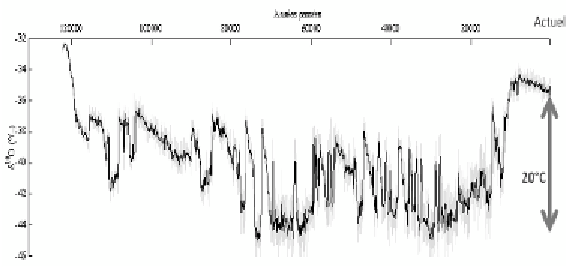Geoscience Reference
In-Depth Information
Years passed
The present
Figure 2.23.
Data for the isotopic composition of ice in oxygen 18 in a core from the
site NorthGrip, in Greenland (from [NOR 04])
2.4.4.
Climatic surprises
In the course of understanding the climate variability and the
associated risks, paleoclimatologists invite us to better regard and
understand what has already occurred on the Earth in other epochs,
particularly during the last million years. The last Ice Age, which
ended around 8,000 years ago, is very informative. Records from ice
cores from Greenland allow us to examine the oxygen isotope content
contained in air bubbles trapped in the ice as they were transformed
from snow into ice. This variable is conveyed in air temperature. The
ice core, associated with a model of the ice age, enables us to
reconstruct the history of the atmospheric local temperature up to the
last million years in the northern caps, such as that of Greenland, and
for the entire period of glacial-interglacial cycles in the Antarctic caps.
The first thing that strikes the observer in the information from
Greenland (see Figure 2.23) is the modification in the shape of the
curve over time: the temperature of the last 8,000 years is almost flat,
whereas the preceding glacial period shows dramatic variations of
more than 10°C. The world of the Ice Age was a world of large
climatic variability, whose instability was without doubt due to the
large quantity of polar caps, these being very unstable. The oceanic
data confirm the existence of instability during the last Glacial
Maximum. They show sedimentary data interspersed with sequences of
mineral debris drawn from continents, signs of the propagation of




